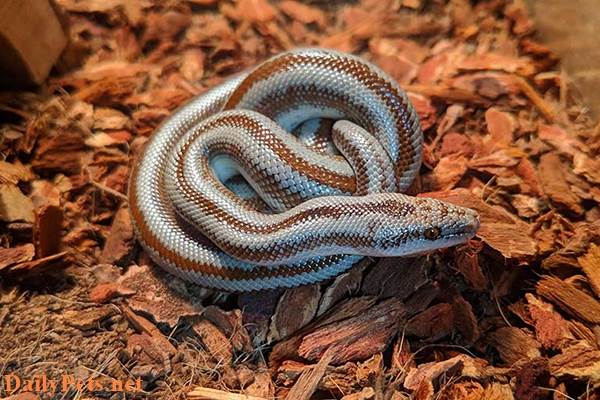The Rosy Boa python is a small South American python, adults only about 43-86cm long.
They are quite docile and harmless to humans, so these pythons are always the ideal choice for beginners to keep reptiles as pets.
About Rosy Boa python
- Scientific name: Lichanura trivirgata
- Family: Erycinidae
- Adult size: From 43cm to 86cm
- Range: Southern California, Northwest Mexico, and Baja California
- Habitat: Desert and arid areas
- Lifespan in captivity: More than 20 years
- Danger: No
- Care Level: Basic
Characteristics of the shape of the Rosy Boa python
The Rosy Boa python is a small, blunt-tailed python with small eyes with vertical pupils due to its nocturnal nature.

Rosy Boa pythons have small dark orange or pink spots on the abdomen. Their dorsal surface is usually dark gray, brown, yellow, or tan, and three light-colored stripes run down the length of the body.
Characteristics of python Rosy Boa
Rosy Boa pythons, like other pythons, hibernate when the weather turns cold.
They are relatively gentle and rarely attack humans. The Rosy Boa is also one of the slowest-moving snakes in the world.
Rosy Boa pythons breed in the spring, about 2-5 children per litter. Rosy Boa pythons are usually between 16 and 23cm long at birth.
How to take care of Rosy Boa python?
Rosy Boa pythons are easy to care for because they can survive and thrive in basic captivity. Besides, this species rarely suffers from common diseases like other python species.
Rosy Boa’s cage
A tank measuring 75m3 is suitable for an adult Rosy Boa. To avoid endangering them, you should use tanks with sturdy lids and small ventilation holes.
The cage should be lined with aspen fibers, sand, or coconut. The substrate must be dry and at least 5cm deep for the python to burrow. Do not line the cage with scented wood such as pine or cedar.
Should put in the cage some basic items such as hiding boxes or empty wood and bowls of water for pythons to drink and soak in.
Maintain the barn temperature at 24 degrees Celsius, which can drop a few degrees at night. In addition, you should also provide a heating area of about 32 degrees Celsius to 37 degrees Celsius in one corner of the cage.
Humidity must be maintained below 50% to keep this species healthy.
Rosy Boa pythons are nocturnal and do not need bright light. However, it is recommended to use a UVB 2.0 ReptiSun bulb to create a clear light cycle.
What do Rosy Boa pythons eat?
The Rosy Boa mainly eats birds, lizards, or small rodents in the wild. However, in captivity, you should only feed them rats because this food is readily available and relatively cheap.















